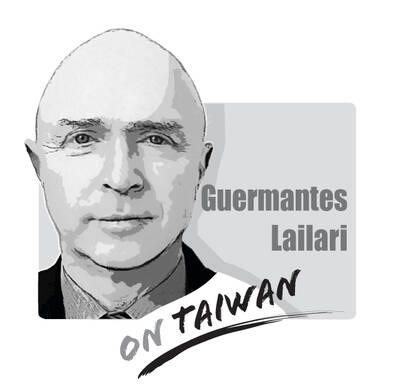Has President Ma Ying-jeou (馬英九) been confirmed to have some kind of psychosis? No. Then the only alternative is to conclude that his delusional ramblings have some actual purpose.
The latest evidence of this was a slip of the tongue when he used the term “one country, two systems” when talking about the “one China” principle in his Nov. 7 meeting with Chinese President Xi Jinping (習近平), as well as him referring to the meeting as “another form of peace agreement.”
He did not misspeak. This was not the verbal equivalent of a typo. He is a believer in “one China” and he is very good at making things up.
Former Chinese leader Deng Xiaoping (鄧小平) came up with the idea of “one country, two systems.” Nobody is disputing that there are two systems, it is just that Taiwanese do not accept the bit about “one country.”
However, Ma has confirmed the so-called “1992 consensus,” and accepted the idea of “one China,” thereby substantiating “one China, two systems.”
Nevertheless, he is still attempting to change his presentation of the meeting with Xi from one of “building bridges” to “another form of peace agreement.”
His persistent touting of his own success in “bridge-building” is strongly reminiscent of former US president Richard Nixon’s harping about his “ice-breaking” visit to China in 1972. That was when Nixon got down on one knee and accepted China’s conditions.
Ma’s meeting with Xi bears strong resemblance to the time former US president Franklin Roosevelt had Patrick Hurley, his personal envoy to former Republic of China (ROC) president Chiang Kai-shek (蔣介石), accompany former Chinese leader Mao Zedong (毛澤東) to Chongqing in 1945 for a meeting with Chiang, fearful that Chiang would throttle Mao.
Ever since he took power in 2008, hoping to intimidate ordinary Taiwanese and to embellish his own achievements, Ma has been repeating over and over, like a senile old man, how he has transformed the Taiwan Strait into a peaceful highway from the “killing fields” of the past.
Yes, he used the Chinese phrase used as the translation of the title of the movie The Killing Fields, which depicted the locations in Cambodia where hundreds of thousands were slaughtered and left to rot by the Khmer Rouge. The Khmer Rouge had taken a leaf out of Mao’s playbook on how to “recreate” and cleanse society.
Yes, the Taiwan Strait has seen opposition and tensions over the years, but what is this talk of it being like the killing fields? The two artillery bombardments of Kinmen do not really count, as they were technically not across the Taiwan Strait, but rather in what was incontrovertibly Chinese territory.
That Taiwan has a democracy and that there is no war across the Taiwan Strait are thanks to the diplomatic intervention and military power of the US, which had nothing to do with Ma allowing Taiwan to be “peacefully annexed.”
Ma only knows how to fabricate or exaggerate the seriousness of past events or situations and inflate his own achievements, while trying to conceal the price that has to be paid.
James Wang is a media commentator.
Translated by Paul Cooper

Chinese state-owned companies COSCO Shipping Corporation and China Merchants have a 30 percent stake in Kaohsiung Port’s Kao Ming Container Terminal (Terminal No. 6) and COSCO leases Berths 65 and 66. It is extremely dangerous to allow Chinese companies or state-owned companies to operate critical infrastructure. Deterrence theorists are familiar with the concepts of deterrence “by punishment” and “by denial.” Deterrence by punishment threatens an aggressor with prohibitive costs (like retaliation or sanctions) that outweigh the benefits of their action, while deterrence by denial aims to make an attack so difficult that it becomes pointless. Elbridge Colby, currently serving as the Under
The Ministry of the Interior on Thursday last week said it ordered Internet service providers to block access to Chinese social media platform Xiaohongshu (小紅書, also known as RedNote in English) for a year, citing security risks and more than 1,700 alleged fraud cases on the platform since last year. The order took effect immediately, abruptly affecting more than 3 million users in Taiwan, and sparked discussions among politicians, online influencers and the public. The platform is often described as China’s version of Instagram or Pinterest, combining visual social media with e-commerce, and its users are predominantly young urban women,
Most Hong Kongers ignored the elections for its Legislative Council (LegCo) in 2021 and did so once again on Sunday. Unlike in 2021, moderate democrats who pledged their allegiance to Beijing were absent from the ballots this year. The electoral system overhaul is apparent revenge by Beijing for the democracy movement. On Sunday, the Hong Kong “patriots-only” election of the LegCo had a record-low turnout in the five geographical constituencies, with only 1.3 million people casting their ballots on the only seats that most Hong Kongers are eligible to vote for. Blank and invalid votes were up 50 percent from the previous
Alarm bells over a “hollowing out” of Taiwan’s semiconductor industry and US demands for “protection money” have fueled a panic over Taiwan. To understand how misplaced these fears are, consider the movements of global technology giants. Nvidia Corp CEO Jensen Huang (黃仁勳), Advanced Micro Devices Inc (AMD) CEO Lisa Su (蘇姿丰) and Taiwan Semiconductor Manufacturing Co (TSMC) chairman C.C. Wei (魏哲家) could undoubtedly understand the situation best, and they continue to make key investments in Taiwan. They do not make decisions on a whim. They are the architects of global computing power strategy and possess the highest levels of industry knowledge. No